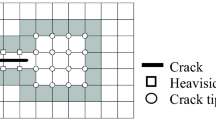Abstract
To simulate the crack growth and study the catastrophic fracture mechanisms of metal films, a computational methodology is developed to simulate the failure process from damage initiation to crack growth and eventually to rupture. In the computational methodology, a procedure is developed based on beam lattice model for considering the coupling interactions among damage and crack evolution. To verify the effectiveness of the developed computational methodology, fracture process of two copper film specimens were simulated and compared with the corresponding experimental results. The results show that the developed methodology is effective, and can be used to simulate the catastrophic fracture process of metal films. From the simulation results, we can find out that the fracture of metal films with initial flaws belongs to brittle fracture, and the regular lattice model can affect the crack path prediction, and random and irregular lattice model is more suitable to simulate crack growth in the developed computational methodology.











Similar content being viewed by others
References
LaVan D A, Boyce B L and Buchheit T E 2003 Int. J. Damage Mech. 12 357
Kivi A R, Azizi S and Khalkhali A 2016 Int. J. Mech. Mater. Des. 12 337
Li Y, Li J and Xu L 2018 Microelectron. Reliab. 85 38
Gao J, Chow P K, Thomas A V, Lu T M, Borca-Tasciuc T and Koratkar N 2014 Appl. Phys. Lett. 105 722
Sun B and Li Z 2019 Acta Mech. 230 2979
Sun B and Li Z 2019 Eur. J. Mech. A: Solid 75 82
Rogers J A 2010 Nature 468 177
Heremans P, Tripathi A K, De Meux A D J, Smits E C P, Hou B, Pourtois G et al 2016 Adv. Mater. 28 4266
Sun B, Huang X and Li Z 2019 Met. Mater. Int. 26 501
Sun Y, Zhai Z, Tian S and Chen X 2019 Appl. Surf. Sci. 480 1100
He X, Chen F and Yin H 2016 Int. J. Damage Mech. 71 423358
Li X, Wei Y, Lu L, Lu K and Gao H 2010 Nature 464 877
You Z S, Li X, Gui L, Lu Q, Zhu T, Gao H et al 2013 Acta Mater. 61 217
Su Y, Wang S, Huang Y A, Luan H, Dong W, Fan J A et al 2015 Small 11 367
Bastawros A F and Kim K S 2001 Int. J. Damage Mech. 10 195
An B and Xu M 2019 Mech. Mater. 136 103084
Zeng Z, Li X, Lu L and Zhu T 2015 Acta Mater. 98 313
Shan Z, Lu L, Minor A M, Stach E A and Mao S X 2008 JOM-US 60 71
Kim S, Li X, Gao H and Kumar S 2012 Acta Mater. 60 2959
Hintsala E, Kiener D, Jackson J and Gerberich W W 2015 Exp. Mech. 55 1681
Singh A, Tang L, Dao M, Lu L and Suresh S 2011 Acta Mater. 59 2437
You Z S, Qu S, Luo S and Lu L 2019 Materialia 7 100430
Yu S, Zhang X, Xiao X, Zhou H and Chen M 2015 Soft Matter 11 2203
An B 2019 Eur. J. Mech. A: Solid 75 1
Sadhukhan S, Kumar A, Kulkarni G U, Tarafdar S and Dutta T 2019 Bull. Mater. Sci. 42 197
Yun K, Wang Z, Chang M, Liu J, Kim T, Son N et al 2019 Comput. Struct. 215 65
Sun B, Wang X and Li Z 2015 Comput. Mater. Sci. 110 39
Amor H, Marigo J and Maurini C 2009 J. Mech. Phys. Solids 57 1209
Sun B and Li Z 2016 Int. J. Damage Mech. 25 750
Miehe C, Hofacker M and Welschinger F 2010 Comput. Methods Appl. Mech. Eng. 199 2765
Borden M J, Verhoosel C V, Scott M A, Hughes T J R and Landis C M 2012 Comput. Methods Appl. Mech. Eng. 217 77
Nguyen T T, Yvonnet J, Zhu Q, Bornert M and Chateau C 2015 Eng. Fract. Mech. 139 18
Erdogan F and Sih G C 1963 J. Basic Eng. 85 519
Sih G C 1974 Int. J. Fract. 10 305
Nuismer R J 1975 Int. J. Fract. 11 245
Azadi H and Khoei A R 2011 Int. J. Numer. Methods Eng. 85 1017
Belytschko T, Chen H, Xu J and Zi G 2003 Int. J. Numer. Methods Eng. 58 1873
Alfaiate J, Wells G N and Sluys L J 2002 Eng. Fract. Mech. 69 661
Bai Y L, Wang H, Xia M and Ke F 2005 Appl. Mech. Rev. 58 372
Sun B and Li Z 2015 Comput. Struct. 152 66
Sun B, Zheng Y and Li Z 2020 Constr. Build. Mater. 244 118396
Sun B 2020 Arab. J. Geosci. 13 1031
Acknowledgements
The works described in this paper are financially supported by National Natural Science Foundation of China (Grant No. 52008104) and National Program on Key R&D Project of China (2020YFB2103500-2), to which we are most grateful. We are very grateful to the reviewers and the editor for their constructive comments and suggestions, which helped us to improve our paper significantly.
Author information
Authors and Affiliations
Corresponding author
Supplementary Information
Below is the link to the electronic supplementary material.
Supplementary file1 (AVI 57342 kb)
Rights and permissions
About this article
Cite this article
Sun, B., Xu, Zd. A continuum damage-based computational methodology for crack growth simulation of metal films. Bull Mater Sci 44, 200 (2021). https://doi.org/10.1007/s12034-021-02430-5
Received:
Accepted:
Published:
DOI: https://doi.org/10.1007/s12034-021-02430-5




